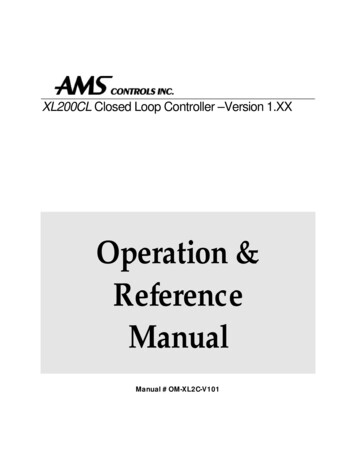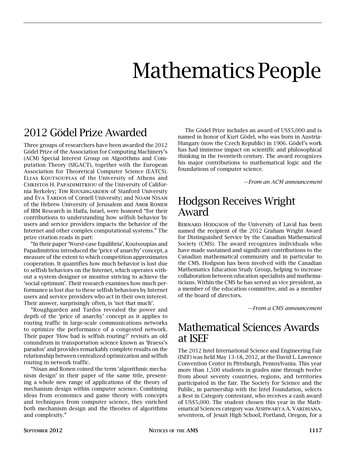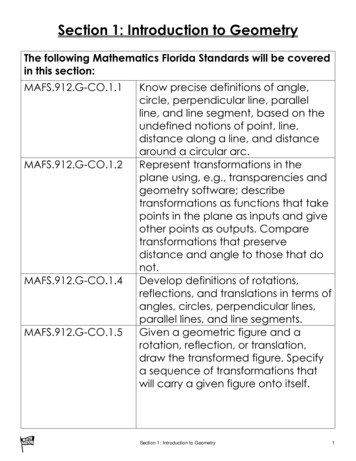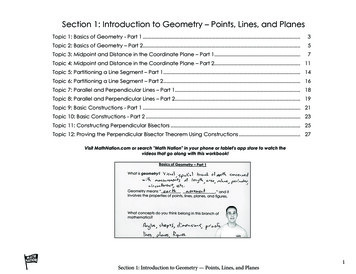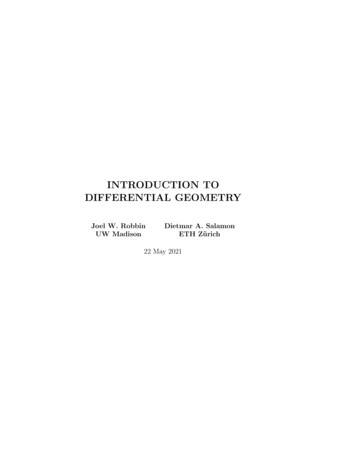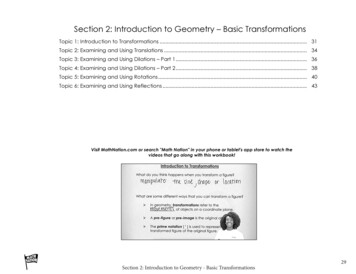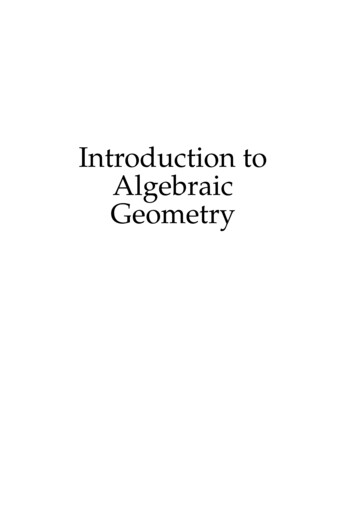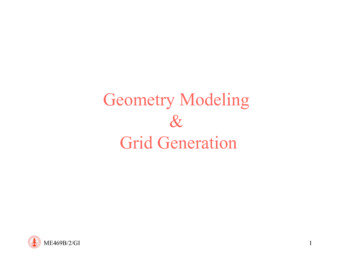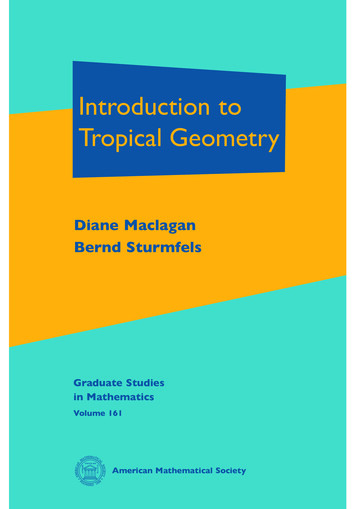
Transcription
Introduction toTropical GeometryDiane MaclaganBernd SturmfelsGraduate Studiesin MathematicsVolume 161American Mathematical Society
Introduction toTropical Geometry
https://doi.org/10.1090//gsm/161Introduction toTropical GeometryDiane MaclaganBernd SturmfelsGraduate Studiesin MathematicsVolume 161American Mathematical SocietyProvidence, Rhode Island
EDITORIAL COMMITTEEDan AbramovichDaniel S. FreedRafe Mazzeo (Chair)Gigliola Staffilani2010 Mathematics Subject Classification. Primary 14T05;Secondary 05B35, 12J25, 13P10, 14M25, 15A80, 52B20.For additional information and updates on this book, visitwww.ams.org/bookpages/gsm-161Library of Congress Cataloging-in-Publication DataMaclagan, Diane, 1974–Introduction to tropical geometry / Diane Maclagan, Bernd Sturmfels.pages cm. — (Graduate studies in mathematics ; volume 161)Includes bibliographical references and indexISBN 978-0-8218-5198-2 (alk. paper)1. Tropical geometry—Study and teaching (Graduate) 2. Geometry, Algebraic—Study andteaching (Graduate) I. Sturmfels, Bernd, 1962– II. Title. III. Tropical geometry.QA582.M33 2015516.3 5—dc232014036141Copying and reprinting. Individual readers of this publication, and nonprofit librariesacting for them, are permitted to make fair use of the material, such as to copy select pages foruse in teaching or research. Permission is granted to quote brief passages from this publication inreviews, provided the customary acknowledgment of the source is given.Republication, systematic copying, or multiple reproduction of any material in this publicationis permitted only under license from the American Mathematical Society. Permissions to reuseportions of AMS publication content are handled by Copyright Clearance Center’s RightsLink service. For more information, please visit: http://www.ams.org/rightslink.Send requests for translation rights and licensed reprints to reprint-permission@ams.org.Excluded from these provisions is material for which the author holds copyright. In such cases,requests for permission to reuse or reprint material should be addressed directly to the author(s).Copyright ownership is indicated on the copyright page, or on the lower right-hand corner of thefirst page of each article within proceedings volumes.c 2015 by the American Mathematical Society. All rights reserved. The American Mathematical Society retains all rightsexcept those granted to the United States Government.Printed in the United States of America. The paper used in this book is acid-free and falls within the guidelines established to ensure permanence and durability.Visit the AMS home page at http://www.ams.org/10 9 8 7 6 5 4 3 2 120 19 18 17 16 15
To Saul and Hyungsook
ContentsPrefaceChapter 1. Tropical Islandsix1§1.1. Arithmetic2§1.2. Dynamic Programming7§1.3. Plane Curves11§1.4. Amoebas and their Tentacles17§1.5. Implicitization21§1.6. Group Theory25§1.7. Curve Counting31§1.8. Compactifications34§1.9. Exercises39Chapter 2. Building Blocks43§2.1. Fields43§2.2. Algebraic Varieties52§2.3. Polyhedral Geometry58§2.4. Gröbner Bases65§2.5. Gröbner Complexes74§2.6. Tropical Bases81§2.7. Exercises89Chapter 3. Tropical Varieties§3.1. Hypersurfaces9393vii
viiiContents§3.2. The Fundamental Theorem102§3.3. The Structure Theorem110§3.4. Multiplicities and Balancing118§3.5. Connectivity and Fans128§3.6. Stable Intersection133§3.7. Exercises149Chapter 4. Tropical Rain Forest153§4.1. Hyperplane Arrangements153§4.2. Matroids161§4.3. Grassmannians170§4.4. Linear Spaces182§4.5. Surfaces192§4.6. Complete Intersections201§4.7. Exercises214Chapter 5. Tropical Garden221§5.1. Eigenvalues and Eigenvectors222§5.2. Tropical Convexity228§5.3. The Rank of a Matrix243§5.4. Arrangements of Trees255§5.5. Monomials in Linear Forms268§5.6. Exercises273Chapter 6. Toric Connections277§6.1. Toric Background278§6.2. Tropicalizing Toric Varieties281§6.3. Orbits291§6.4. Tropical Compactifications297§6.5. Geometric Tropicalization309§6.6. Degenerations322§6.7. Intersection Theory334§6.8. Exercises346Bibliography351Index361
PrefaceTropical geometry is an exciting new field at the interface between algebraicgeometry and combinatorics with connections to many other areas. At itsheart it is geometry over the tropical semiring, which is R { } with theusual operations of addition and multiplication replaced by minimum andaddition, respectively. This turns polynomials into piecewise-linear functions and replaces an algebraic variety by an object from polyhedral geometry, which can be regarded as a “combinatorial shadow” of the originalvariety.In this book we introduce this subject at a level that is accessible tobeginners. Tropical geometry has become a large field, and only a smallselection of topics can be covered in a first course. We focus on the study oftropical varieties that arise from classical algebraic varieties. Methods fromcommutative algebra and polyhedral geometry are central to our approach.This necessarily means that many important topics are left out. These include the systematic development of tropical geometry as an intrinsic geometry in its own right, connections to enumerative and real algebraic geometry,connections to mirror symmetry, connections to Berkovich spaces and abstract curves, and the more applied aspects of max-plus algebra. Luckilymost of these topics are covered in other recent or forthcoming books, suchas [BCOQ92], [But10], [Gro11], [IMS07], [Jos], [MR], and [PS05].Prerequisites. This text is intended to be suitable for a class on tropical geometry for first-year graduate students in mathematics. We haveattempted to make the material accessible to readers with a minimal background in algebraic geometry, at the level of the undergraduate text bookIdeals, Varieties, and Algorithms by Cox, Little, and O’Shea [CLO07].ix
xPrefaceEssential prerequisites for this book are mastery of linear algebra andthe material on rings and fields in a first course in abstract algebra. Sincetropical geometry draws on many fields of mathematics, some additionalbackground in geometry, topology, or number theory will be beneficial.Polyhedra and polytopes play a fundamental role in tropical geometry,and some prior exposure to convexity and polyhedral combinatorics mayhelp. For that we recommend Ziegler’s book Lectures on Polytopes [Zie95].Chapter 1 offers a friendly welcome to our readers. It has no specificprerequisites and is meant to be enjoyable for all. The first three sections inChapter 2 cover background material in abstract algebra, algebraic geometry, and polyhedral geometry. Enough definitions and examples are giventhat an enthusiastic reader can fill in any gaps. All students (and theirteachers) are strongly urged to explore the exercises for Chapters 1 and 2.Some of the results and their proofs will demand more mathematical maturity and expertise. Chapters 2 and 3 require some commutative algebra.Combinatorics and multilinear algebra will be useful for studying Chapters4 and 5. Chapter 6 assumes familiarity with modern algebraic geometry.Overview. We begin by relearning the arithmetic operations of additionand multiplication. The rest of Chapter 1 offers tapas that can be enjoyedin any order. They show a glimpse of the past, present, and future of tropicalgeometry and serve as an introduction to the more formal contents of thisbook. In Chapter 2, the first half covers background material, while thesecond half develops a version of Gröbner basis theory suitable for algebraicvarieties over a field with valuation. The highlights are the construction ofthe Gröbner complex and the resulting finiteness of tropical bases.Chapter 3 is the heart of the book. The two main results are the Fundamental Theorem 3.2.3, which characterizes tropical varieties in seeminglydifferent ways, and the Structure Theorem 3.3.5, which says that they areconnected balanced polyhedral complexes of the correct dimension. Stableintersections of tropical varieties reveal a hint of intersection theory.Tropical linear spaces and their parameter spaces, the Grassmannian andthe Dressian, appear in Chapter 4. Matroid theory plays a foundational role.Our discussion of complete intersections includes mixed volumes of Newtonpolytopes and a tropical proof of Bernstein’s Theorem for n equations in nvariables. We also study the combinatorics of surfaces in 3-space.Chapter 5 covers spectral theory for tropical matrices, tropical convexity,and determinantal varieties. It also showcases computations with Bergmanfans of matroids and other linear spaces. Chapter 6 concerns the connection between tropical varieties and toric varieties. It introduces the tropicalapproach to degenerations, compactifications, and enumerative geometry.
PrefacexiTeaching possibilities. A one-semester graduate course could be basedon Chapters 2 and 3, plus selected topics from the other chapters. Onepossibility is to start with two or three weeks of motivating examples selectedfrom Chapter 1 before moving on to Chapters 2 and 3. A course for moreadvanced graduate students could start with Gröbner bases as presented inthe second half of Chapter 2, cover Chapter 3 with proofs, and end witha sampling of topics from the later chapters. Students with an interest incombinatorics and computation might gravitate toward Chapters 4 and 5.An advanced course for students specializing in algebraic geometry wouldfocus on Chapters 3 and 6. Covering the entire book would require a fullacademic year or an exceptionally well-prepared group of participants.We have attempted to keep the prerequisites low enough to make parts ofthe book appropriate for self-study by a final-year undergraduate. The sections in Chapter 2 could serve as first introductions to their subject areas. Asimple route through Chapter 3 is to focus in detail on the hypersurface case,and to discuss the Fundamental Theorem and Structure Theorem withoutproofs. The exercises suggest many possibilities for senior thesis projects.Acknowledgments. We have drawn on the rich and ever-growing literature in tropical geometry when preparing this book. While most directsources are mentioned, the bibliography is by no means complete. We thankthe authors whose work we have drawn on for their inspiration and apologizefor any omissions. Readers are encouraged to search the keywords of thisbook and the MSC code 14T05 to explore this beautiful subject, includingthe topics missing from this book.We are grateful to the many readers who have offered mathematical helpand comments on drafts of this book during its long incubation. These include Frank Ban, Roberto Barrera, Florian Block, Lucia Caporaso, DustinCartwright, Federico Castillo, Andrew Chan, Melody Chan, Angelica Cueto,Jan Draisma, Mareike Dressler, Laura Escobar, Rodrigo Ferreira da Rosa,Gunnar Fløystad, Jennifer Garcia Castilla, Falko Gauss, Noah Giansiracusa,Walter Gubler, Maria Isabel Herrero, June Huh, Florencia Orosz Hunziker,Nathan Ilten, Anders Jensen, Michael Joswig, Dagan Karp, Steven Karp,Sara Lamboglia, Hwangrae Lee, Yoav Len, Bo Lin, Madhusudan Manjunath, Hannah Markwig, Ralph Morrison, Benjamin Nill, Mounir Nisse, JinHyung Park, Sam Payne, Nathan Pflueger, Dhruv Ranganathan, FelipeRincón, Kristin Shaw, Erez Sheiner, David Speyer, Stefan Stadlöder, Jenia Tevelev, Ngoc Mai Tran, Paolo Tripoli, Emanuel Tsukerman, Jan Verschelde, Daping Weng, Annette Werner, Jessie Yang, Josephine Yu, Magdalena Zajaczkowska, and Dylan Zwick. Some of this book was written whenthe authors were both resident at various mathematics institutes. Particular thanks to MSRI (Berkeley), MPIM (Bonn), and NIMS (Daejeon) for
xiiPrefacetheir hospitality. A skeleton of parts of the book was created in the lecturenotes the first author wrote for a four-week AARMS (Atlantic Associationfor Research in the Mathematical Sciences) summer school in 2008. Thanksto Colin Ingalls, Barry Monson, and Hugh Thomas for that opportunity.This project was partially supported by the U.K. Engineering and PhysicalSciences Research Council and the U.S. National Science Foundation.Diane MaclaganMathematics InstituteUniversity of WarwickCoventry, CV4 7ALUnited KingdomBernd SturmfelsDepartment of MathematicsUniversity of CaliforniaBerkeley, CA 94720United States
Bibliography[ABBR13] Omini Amini, Matthew Baker, Erwan Brugallé, and Joseph Rabinoff, Liftingharmonic morphisms I: metrized complexes and Berkovich skeleta, arXiv:1303.4812, 2013. 334[AD09]Federico Ardila and Mike Develin, Tropical hyperplane arrangements and oriented matroids, Math. Z. 262 (2009), no. 4, 795–816. 239, 266[AK06]Federico Ardila and Caroline J. Klivans, The Bergman complex of a matroidand phylogenetic trees, J. Combin. Theory Ser. B 96 (2006), no. 1, 38–49. 167[AKW06]Federico Ardila, Caroline Klivans, and Lauren Williams, The positiveBergman complex of an oriented matroid, European J. Combin. 27 (2006),no. 4, 577–591. 275[AR10]Lars Allermann and Johannes Rau, First steps in tropical intersection theory,Math. Z. 264 (2010), no. 3, 633–670. 145, 346[AZ04]Martin Aigner and Günter M. Ziegler, Proofs from The Book, third ed.,Springer-Verlag, Berlin, 2004. 247[Bak08a]Matthew Baker, An introduction to Berkovich analytic spaces and nonArchimedean potential theory on curves, p-adic geometry, Univ. Lecture Ser.,vol. 45, Amer. Math. Soc., Providence, RI, 2008, pp. 123–174. 311[Bak08b], Specialization of linear systems from curves to graphs, Algebra Number Theory 2 (2008), no. 6, 613–653. 334[BCOQ92] François Louis Baccelli, Guy Cohen, Geert Jan Olsder, and Jean-PierreQuadrat, Synchronization and linearity: An algebra for discrete event systems, John Wiley & Sons Ltd., Chichester, 1992. ix, 4, 228[Ber71]George M. Bergman, The logarithmic limit-set of an algebraic variety, Trans.Amer. Math. Soc. 157 (1971), 459–469. 17, 20, 21, 28[Ber75]D. N. Bernstein, The number of roots of a system of equations, Funkcional.Anal. i Priložen. 9 (1975), no. 3, 1–4. 210[BG84]Robert Bieri and J. R. J. Groves, The geometry of the set of cha
geometry and serve as an introduction to the more formal contents of this book. In Chapter 2, the first half covers background material, while the second half develops a version of Gr obner basis theory suitable for algebraic varieties over a field with valuation. The highlights are the construction of the Gr obner complex and the resulting finiteness of tropical bases. Chapter 3 is the .


